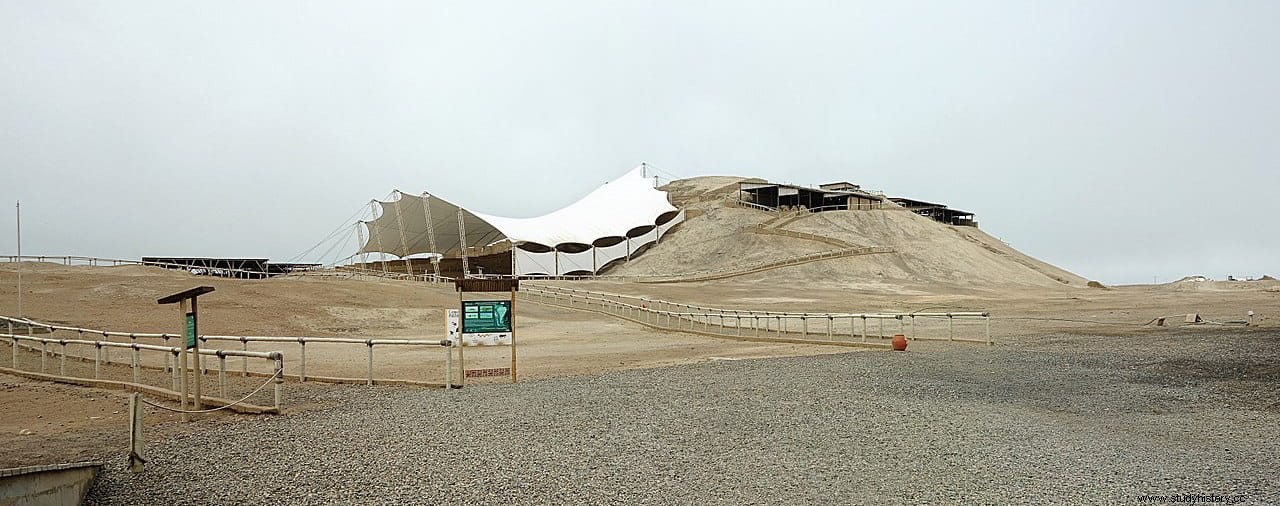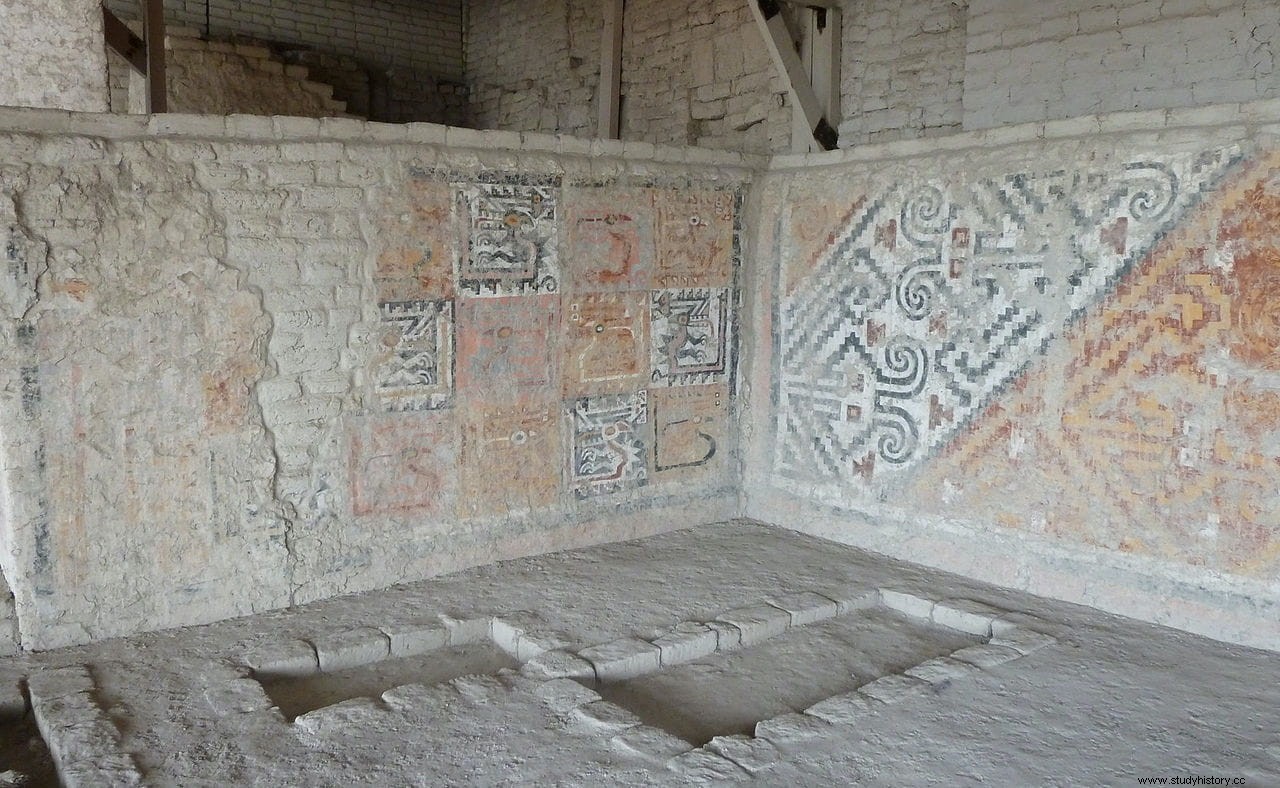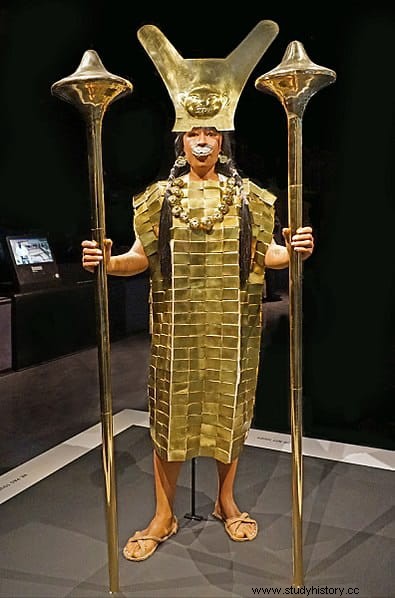Some time ago we talked here about a Chinese warlord named Cao Cao. Today we are going to see someone of the opposite sex and very different, both geographically and chronologically, although with a similar name:the Lady of Cao, the name by which an American mummy is known, from the Mochica culture, whose mortal remains and their fantastic funerary trousseau were found in Peru and today they are preserved -and can be seen- in a specific room of the Cao Museum, erected ad hoc in the same place.
It all started in El Brujo, an archaeological site located in the Peruvian department of La Libertad. That part of the country corresponded to Chinchaysuyo, the northernmost and most populous suyu of the Inca empire and which, together with Cuntinsuyo, Collasuyo and Antisuyo, formed the four administrative divisions of the Inca empire. In his case, it ranged from the upper half of present-day Peru to southern Colombia, passing through Ecuador and including part of the Andes and the western end of the Amazon.

It was the territory that the Inca Pachacútec conquered around 1470 from the ancient Chimú Kingdom, which in turn had succeeded the Huari Empire in the 13th century. But much earlier, in the northern area, corresponding to the valley of the Moche River (in what is now the province of Trujillo), there was another culture whose name derives precisely from that place. It developed between the 2nd and 5th centuries AD, during the so-called Early Intermediate Period, and is therefore contemporary with the Nazca, Lima, Recuay, Cajamarca and Tihuanaco cultures.
The Moche or Mochica culture was identified in 1909 by the German archaeologist Max Uhle, who was director of the Archaeological section of the Historical Museum of Lima and later would also work in Chile and Ecuador, although most of the excavations were carried out by his assistant, Heincrich Brüning. If from the Chimú we still preserve the splendid adobe city of Chan Chan, from the Mochica there remain a handful of imposing archaeological sites, in two of which burials were discovered that currently constitute not only a fundamental source of information for historians but also an important tourist attraction.

And it is that places as fascinating as the huacas del Sol y la Luna were partially overshadowed between the last quarter of the 20th century and the beginning of the 21st with the discovery of the tombs of the Lord of Sipán (1987) and the Lady of Cao (2006). The first caused a sensation because it was the only tomb of a ruler of ancient Peru that was intact, with no signs of looting. The second even surpassed the first because the character buried, also in the midst of riches, was a woman, which revealed valuable data on the situation of her sex in access to power.
El Brujo is an archaeological complex located in the Chicama river valley and made up of Huaca Prieta, Huaca Cortada and Huaca Cao Viejo. The huacas (literally sacred places) are usually tombs and in the last mentioned, a truncated pyramid made of seven superimposed platforms with a total of 120 meters on each side by 30 meters high, the Peruvian team of archaeologist Régulo had been working since the nineties Franco, with the support of the Wiese Foundation, when, in 2006, in a grave 2.5 meters deep, he discovered the mummified remains of a woman wrapped in a funerary bundle of 25 layers of different fabrics and whose weight reached 120 kilos.
Wrapped in a cotton shroud interspersed with copper plates, her hair combed into two braids and her face covered with a metal bowl, the body rested together with a lavish trousseau:44 gold and silver nose rings, various other jewels (crowns, diadems, earmuffs), 18 necklaces of precious stones, a pair of wooden scepters lined with copper (each one 1.75 meters high), an armor of 1,100 pieces of the same metal, weapons (propellants, above all), vessels… She was also not alone, because five other people were buried with her in other graves:two priests, two guards and an adolescent sacrificed by strangulation, all placed in a 275-square-meter chamber decorated with cosmological-themed murals.

The set revealed a high social position of the character, accentuated by the fact that she had her skin tattooed, a symbol that she held an important position; It is not known if this would be political or religious, but the fact that the motifs were fauna associated with the fertility of the land (spiders, snakes, crocodiles, bees...) probably points to the latter, perhaps being a fortune teller or priestess, something that, probably, he made compatible with government work.

In other words, the Lady of Cao, as she was baptized, was a very important character, almost divine, despite her small size (she is barely 1.48 tall) and her youth (she is estimated to be around 20 or 25 years old). the time of death). The good condition of the mummy, due in part to the fact that the body and its clothing were treated with salt and cinnabar (a red mineral composed of mercury sulfide, which has preservative properties) and in part to the fact that it was freed from floods and humidity ( being on an intermediate platform of the huaca), has allowed to clarify some circumstances of his death.
For example, a medical analysis revealed that she had a distended belly and other signs of postpartum eclampsia. Eclampsia consists of a series of seizures, hypertension and edema that some women suffer during and after pregnancy, which can lead to coma and death, as was apparently the case of the Lady of Cao. We do not know what became of her baby, since there are no sources that even speak of her; all we know is the information provided by her body and tomb, although experts remember that only 5% of El Brujo has been excavated.

What we can do here to better understand this is to contextualize it. The Lady of Cao perished around the year 400 AD, the same year that the Romans Honorius and Arcadius reigned in the Western and Eastern empires respectively, the Visigoth Alaric invaded the Italian peninsula, the Great Zimbabwe was built in Africa and Hypatia was named director of the neoplatonic school.
With regard to their own world, the Mochica, the discovery has meant a true revolution by revealing that in that civilization, in which a central sovereign reigned over more or less autonomous lordships, led by priest-warriors (such as the aforementioned Lord of Sipán), the leaders were not exclusively male. Women could also reach the head of government and this was corroborated by the discovery in 2011 of the tomb of another priestess in Chornancap, who had also been a leader of her community; It is true that it belonged to another much later culture, the Lambayeque, in the 13th century.
